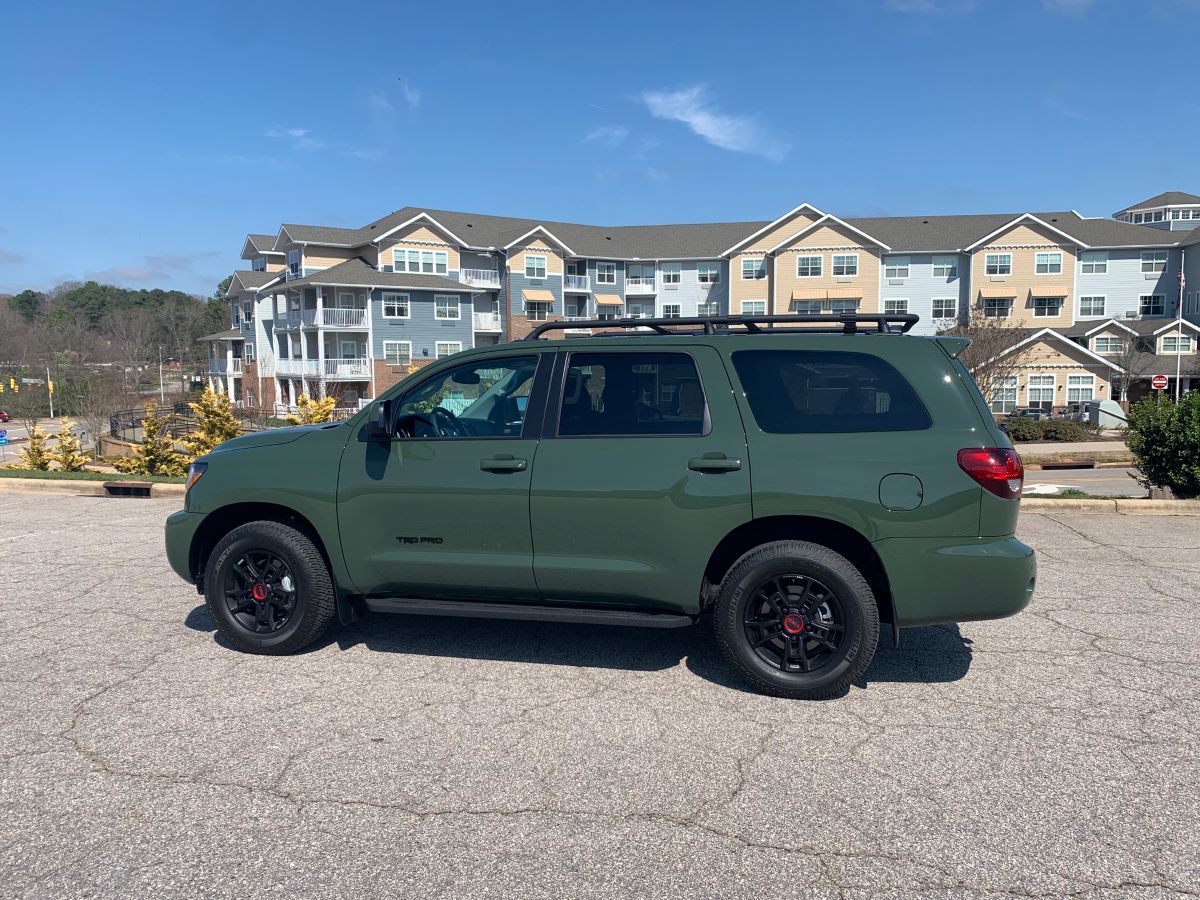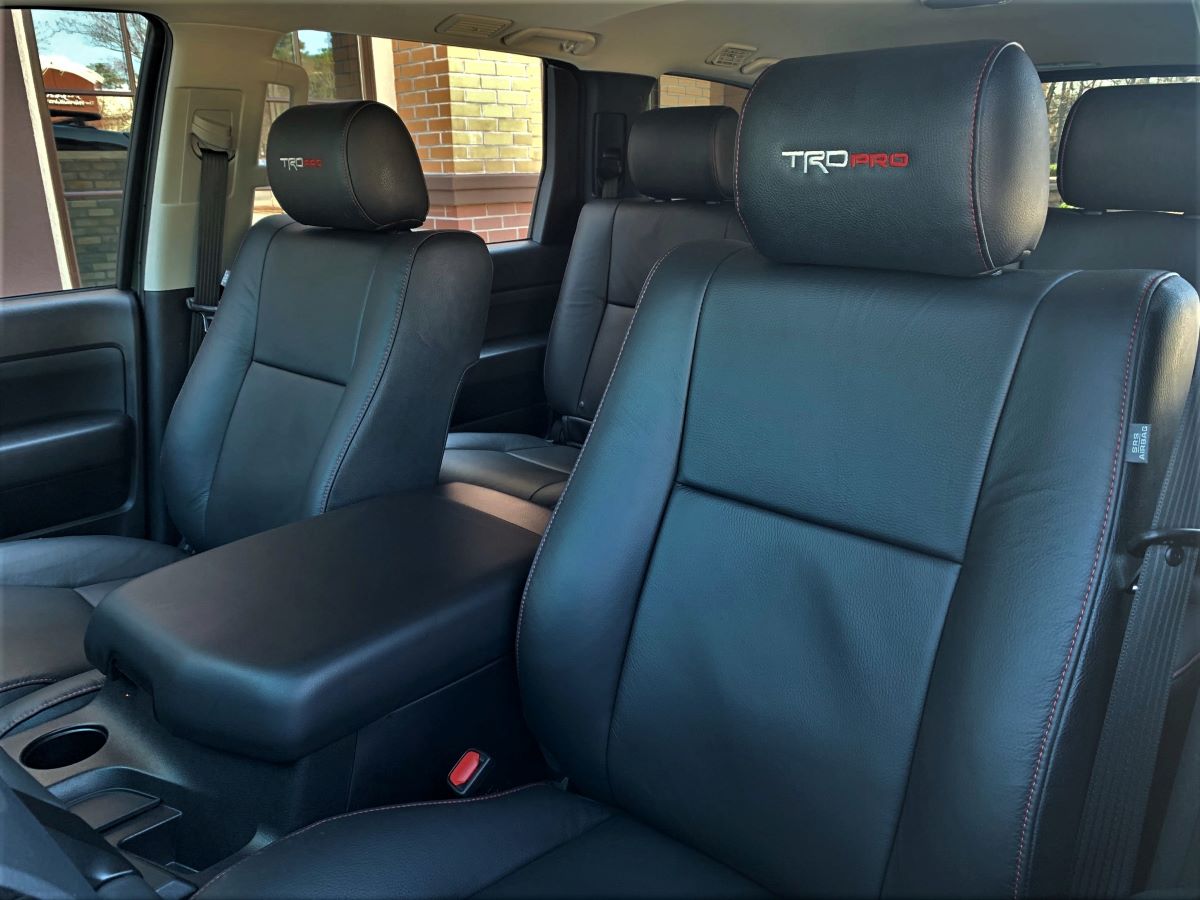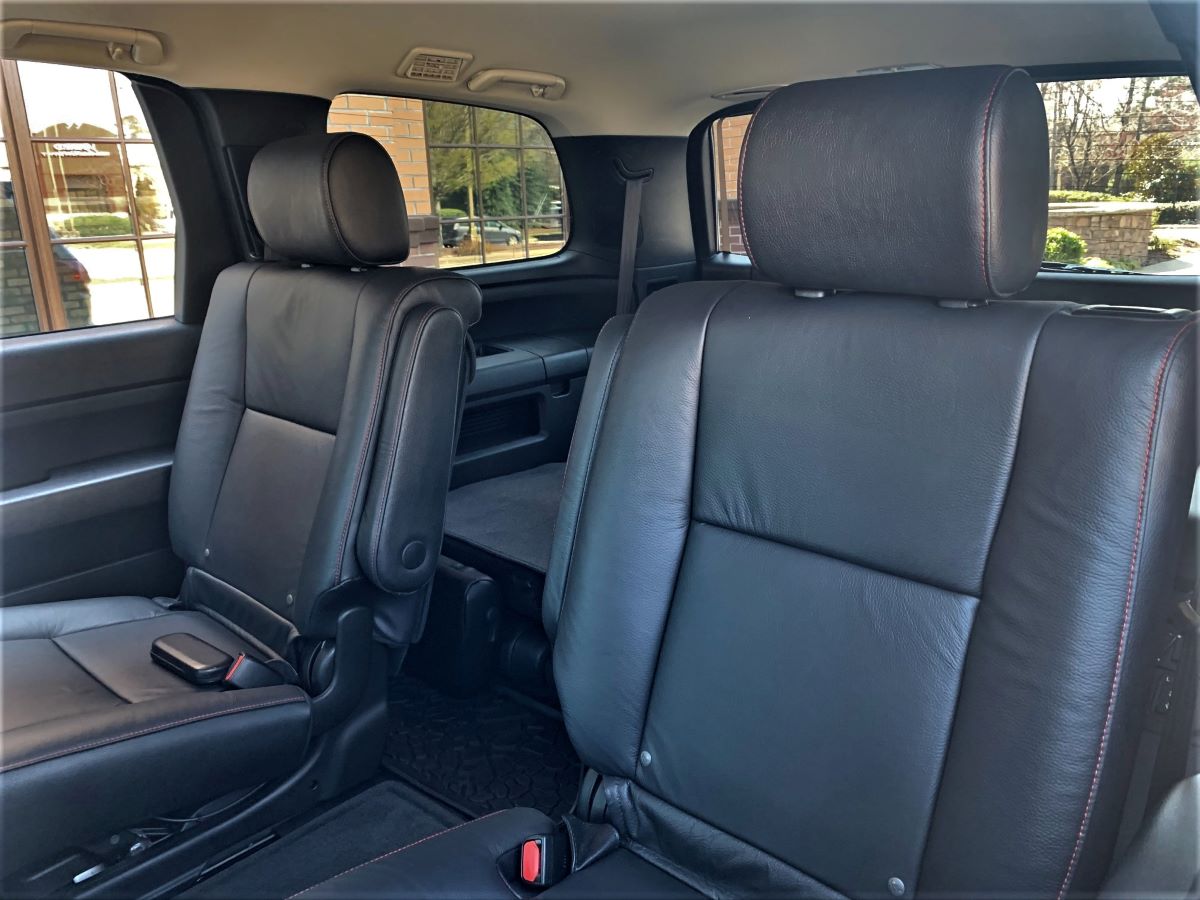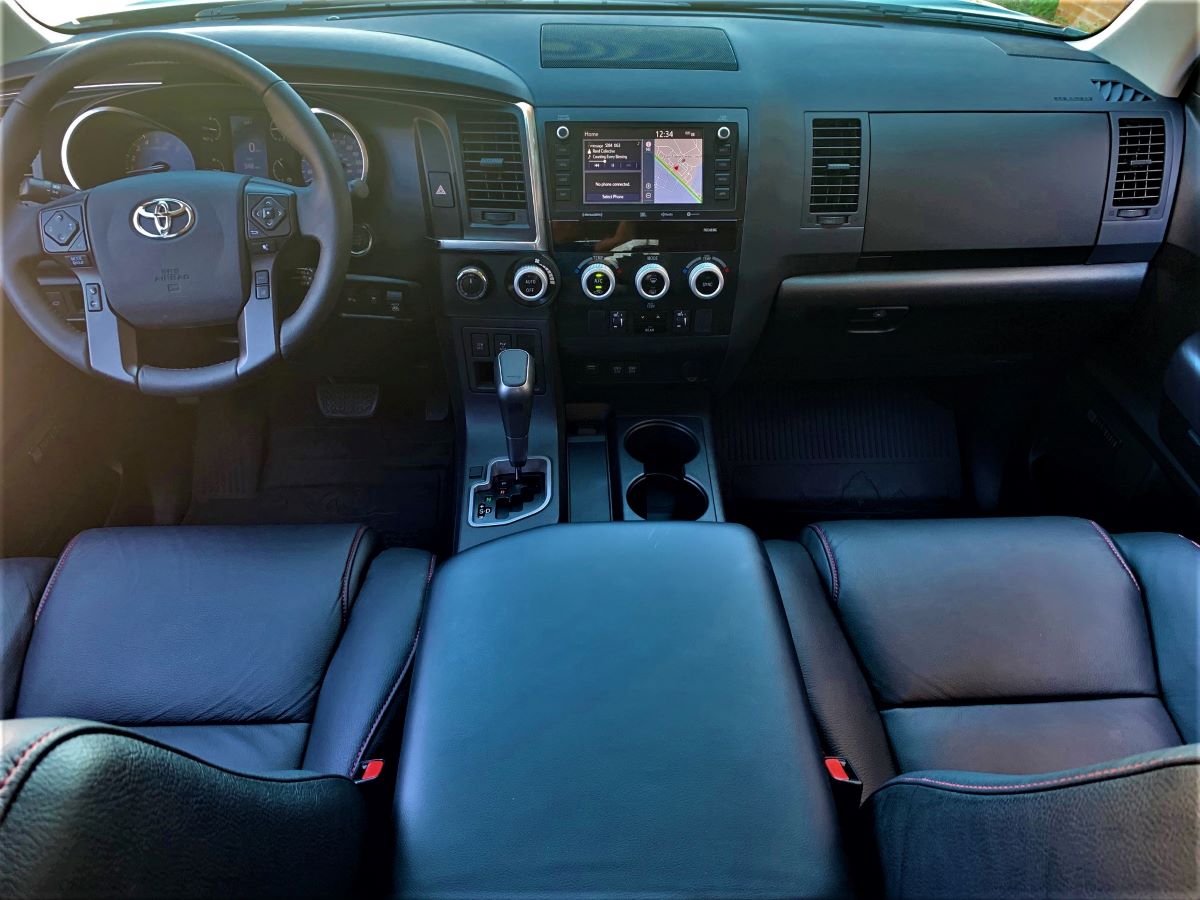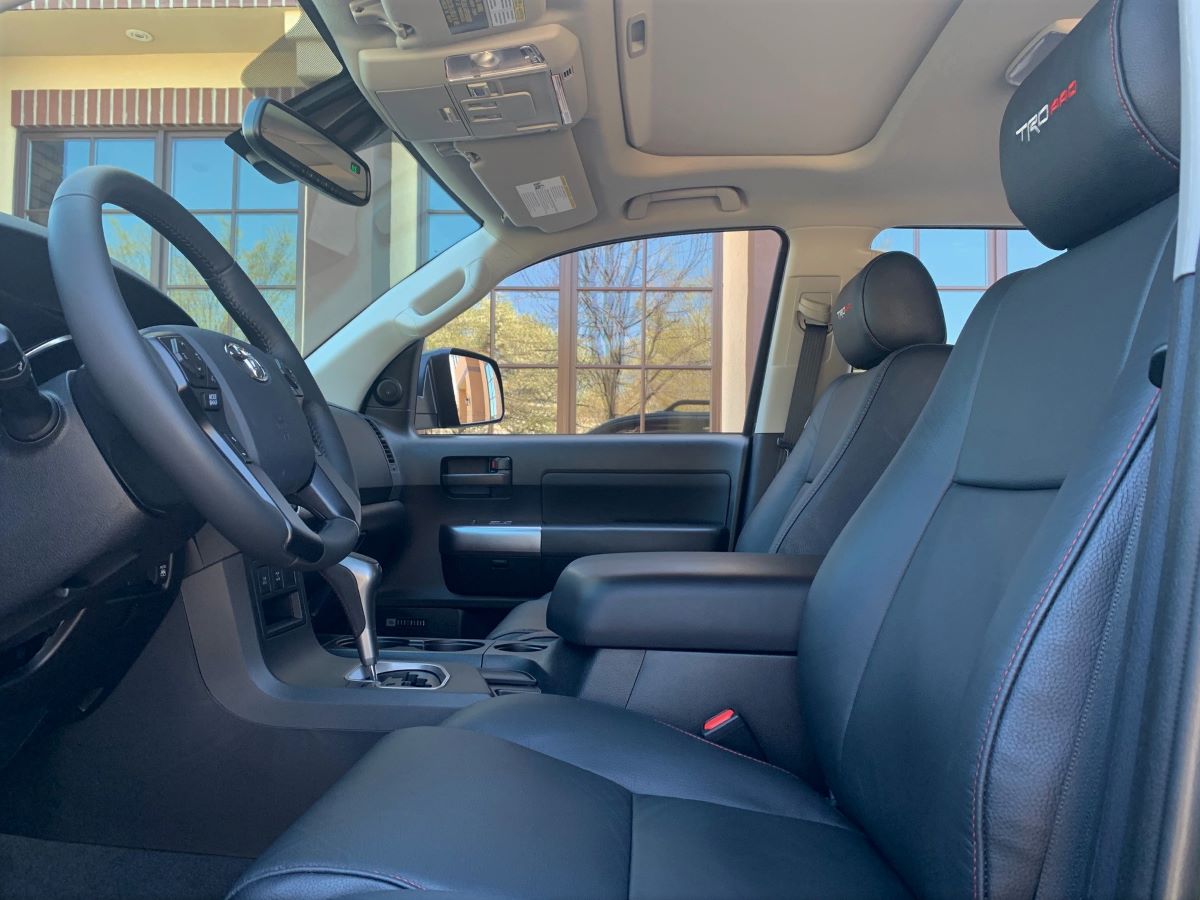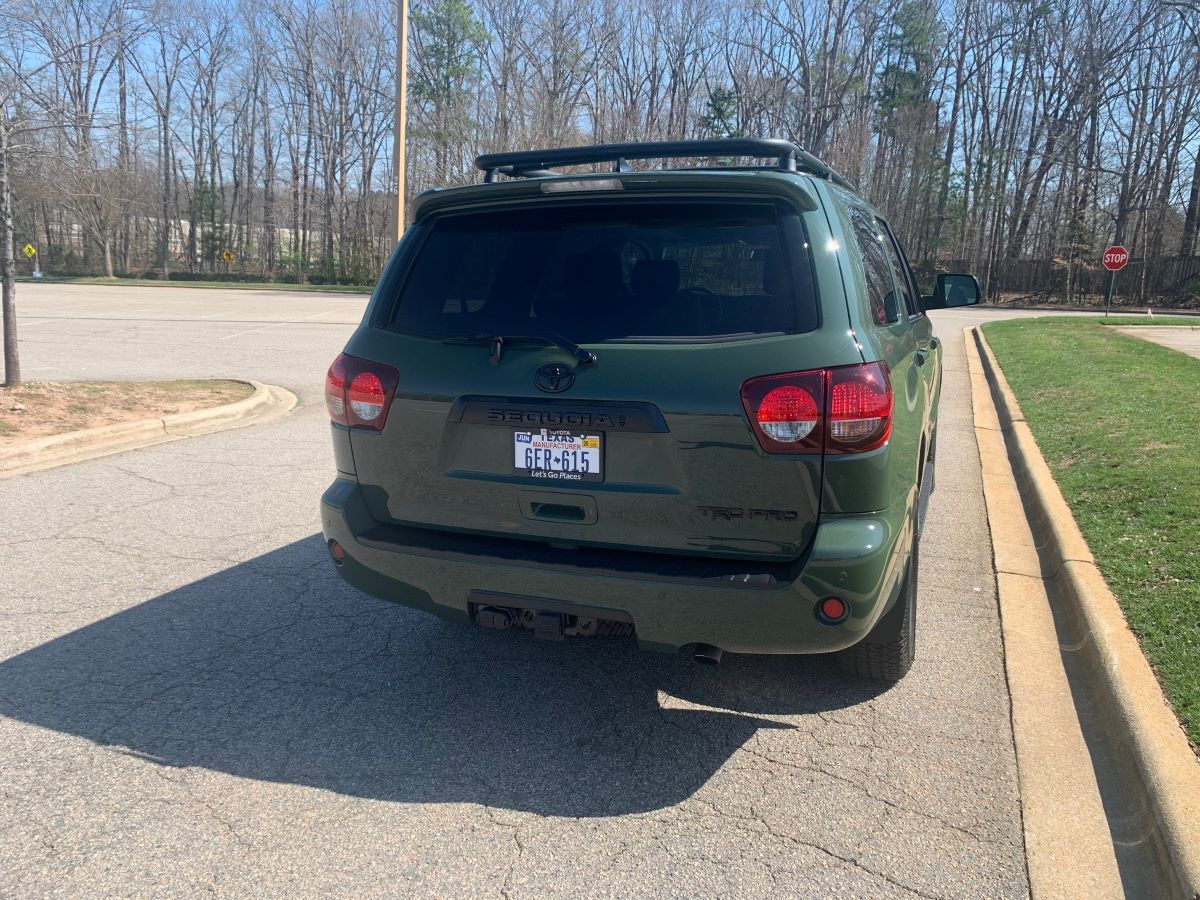The Toyota Sequoia is an enormous sport utility vehicle with room for seven. It is part of a small breed of traditional, truck-based models. In this case, it shares its underpinnings with the full-size Toyota Tundra pickup truck.
Though the market has shifted dramatically to car-based crossover utility vehicles, the Sequoia maintains its appeal in a niche dedicated to recreational pursuits, including camping, boating, fishing, and off-roading.
See Also – 2023 Toyota Sequoia Review
2020 Toyota Sequoia Review
For 2020, the Toyota Sequoia serves up its first TRD Pro trim, which was our test model. This year, the Tundra gains a new 7-inch touch-screen display with Apple CarPlay and Android Auto capability.
Toyota offers the 2020 Sequoia in standard rear-wheel drive or available four-wheel drive. There are five trims for the choosing: SR5 ($49,980), TRD Sport ($52,695), Limited ($58,990), Platinum ($66,020), and TRD Pro ($64,105). Add $1,395 for the destination charge.
Exterior
What sets the TRD Pro apart from the Sequoia pack?
A few things, including its big “TOYOTA” grille, Rigid LED fog lights, its Army Green patina, TRD black roof rack, 18-inch BBS forged-aluminum beaded wheels, and its black running boards. Together, these features represent distinctive items on the Sequoia.
The Sequoia’s canvas is as you would expect: raised, with strong shoulders, upright pillars, a slab body, and huge doors. Most trims come with LED headlamps, power-controlled and heated side mirrors, a power tilt-and-slide moonroof with a sunshade, and a power liftgate.
Interior
The Sequoia, along with the Toyota Land Cruiser, bring the full-bodied interior room to bear. But the Sequoia is slightly larger and better suited to hold the seven people it is designed to carry. The first two rows hold two individuals each with three-placement seating in the third row.
As expected, the best seats are upfront. They’re designed to cosset the driver and passenger, with ample back, hip, and thigh support. Do you wonder why some people are drawn to these types of vehicles? If they’re 6-foot-5-inches or taller, you’d understand.
We’re glad Toyota didn’t try to squeeze a bench seat in the second row. One would fit (and is available, if you must), but it would have rendered the third row mostly useless, especially for tall individuals.
The second-row captain’s chairs, however, are supportive and comfortable on their own. They also fold and move forward for ease of access to the third row. That last row is best used by children, but adults can fit there for short trips.
The Sequoia’s interior is well behind the pack. It is more than a decade old and it looks it. The Expedition is the standard-bearer here and the two are far apart in looks (new GMC and Chevrolet models are on the way for 2021).
The big knobs overwhelm the already large dashboard and the bulky center console. Average materials cover the cabin, including various painted silver trim touchpoints. We like the big center storage console and the double glove box, however.
You’ll find climate control, full power accessories, and power-controlled front seats. Most trims feature leather-covered seats. Heated and ventilated front seats are available.
Tech
Toyota cautiously expanded its smartphone capabilities, by first ensuring both Apple CarPlay and Android Auto were compatible with its systems. Once it closed whatever gaps in proprietary software there were, it introduced the former followed by the latter.
This year, the Sequoia has both systems available and a new touch-screen display at the ready.
The Sequoia TRD Pro comes with an 8-speaker audio system, satellite radio, HD Radio, Bluetooth and Amazon Alexa connectivity, and two USB ports. Some trims include or offer navigation, but with Apple CarPlay and Android Auto, it isn’t necessary.
JBL audio systems and a rear DVD entertainment system are other options of note.
Safety
Every Sequoia trim comes with Toyota Safety Sense P (TSS-P), a package that includes automatic headlamps, a pre-collision system with pedestrian detection, lane departure alert, and dynamic cruise control.
That’s not as generous a package and you’d find on more modern Toyota models, which come with such features as lane tracing assist and rear braking, but it is a welcome offering nonetheless.
Some trims, including the TRD Pro, come with blind-spot monitoring with rear cross-traffic alert. Lane change assist and trailer sway control are also included.
Performance
Motivating the 2020 Sequoia is a Toyota V8 mainstay: a 5.7-liter engine with 381 horsepower and 401 pound-feet of torque. It is the largest V8 that Toyota has ever offered in the U.S. Power travels to the rear or all four wheels, utilizing a 6-speed automatic transmission.
This powertrain combination is up to the task, but it isn’t the best in the industry. Ford with its twin-turbo V6 and GM with its small-block V8 offers more powerful and/or efficient options.
Indeed, the Ford Expedition delivers more power and efficiency, while the Chevrolet Tahoe’s engine utilizes cylinder deactivation for improved fuel economy. Both manufacturers pair these engines with 10-speed automatic transmissions.
The Sequoia shows no lack of step-off power, accelerating steadily as it approaches highway speeds. But it is when operating under full throttle that the differences between this powertrain and its chief competitors become noticeable.
The Sequoia’s transmission simply takes its time to find the right gear for the moment, whereas the Ford and GM units work fast and seamlessly.
No big SUV can handle twisty roads and cornering like a car, and we wouldn’t expect it to. After all, the high profile and steep payload combine to limit what this vehicle can do when it isn’t driving in a straight line.
Perhaps one of the most favorable attributes of our TRD Pro test model is its off-road capabilities. We weren’t able to take it on our favorite trails, which were still closed for the winter.
But, gravel-covered backroads and adjacent clay sloughs proved its mettle. Indeed, we wouldn’t hesitate to take the Sequoia off-road except down narrow trails where a big SUV simply doesn’t belong.
In TRD Pro guise, the Sequoia shines brightest, thanks to ample under-body cladding. It also comes with Fox shock absorbers, designed to increase damping force for a more comfortable ride on the toughest terrain. It has a cat-back exhaust system, one that purrs when idling and roars under hard throttle.
Depending on the model, the 2020 Sequoia pulls between 7,000 to 7,400 pounds. That’s less than its competitors, but at least Toyota supplies a strong engine to handle the work.
As for fuel efficiency, you’ll be hard-pressed to achieve the EPA-estimated 15 mpg combined this model delivers. At least it takes less-costly regular grade unleaded gasoline.
Competitive Set
There are very few mainstream competitors operating in the full-size SUV sphere. You’ll find the Ford Expedition, GMC Yukon, and Chevrolet Tahoe, along with the Nissan Armada. There are a few other models to consider, including the Chevrolet Suburban and the GMC Yukon XL.
Our Recommendation
If you’re in pursuit of off-road adventuring, then the TRD Pro is the right place to look. It comes fully loaded with no options packages available, making its approximate $65,000 published cost a decent value in the segment. Discounting, though, should shave several thousands of dollars off your final cost.
2020 Toyota Sequoia Specifications
| Toyota | 2020 Sequoia |
|---|---|
| Segment | Full-size SUV |
| Price Range | $49,980 to $66,020 |
| Destination Charge | $1,395 |
| Standard Engine | 5.7-liter, V8 |
| Horsepower | 381 @ 5,600 rpm |
| Torque (lb.-ft.) | 401 @ 3,600 rpm |
| Transmission | 6-speed automatic |
| Seating | 8 |
| Curb Weight (pounds) | 5,730 to 6,000 |
| Wheelbase (inches) | 122.0 |
| Length (inches) | 205.1 |
| Width (inches) | 79.9 |
| Height (inches) | 77.0 |
| Headroom (f,r…inches) | 34.8, 34.9, 34.5 |
| Legroom (f,r…inches) | 42.5, 40.9, 35.3 |
| Shoulder room (f,r…inches) | 66.4, 65.6, 65.7 |
| Hip room (f,r…inches) | 62.5, 59.9, 50.4 |
| Storage (cubic feet) | 18.9, 66.6, 120.1 |
| Gross vehicle weight (pounds) | 7,100 to 7,300 |
| Towing (pounds) | 7,000 to 7,400 |
| Payload (pounds) | 1,300 to 1,405 |
| Fuel | regular |
| Fuel Tank (gallons) | 26.4 |
| EPA Fuel MPG (city/highway/combined) | 13/18/15 (2WD) 13/17/14 (4WD) |
| Manufacturing Plant | Princeton, Indiana |
Data compiled by Tom Keegan. Specifications supplied by the manufacturer.
See Also – The History of the Toyota Sequoia
Photos copyright Auto Trends Magazine. All rights reserved.
- 2024 Mazda CX-50: A Compact SUV with Premium Aspirations - Apr 15, 2024
- 2024 Ford Mustang (Iconic Pony Car Evolves) - Apr 4, 2024
- 2024 Ford Maverick (Looks Like a Truck, Drives Like a Car) - Mar 28, 2024


